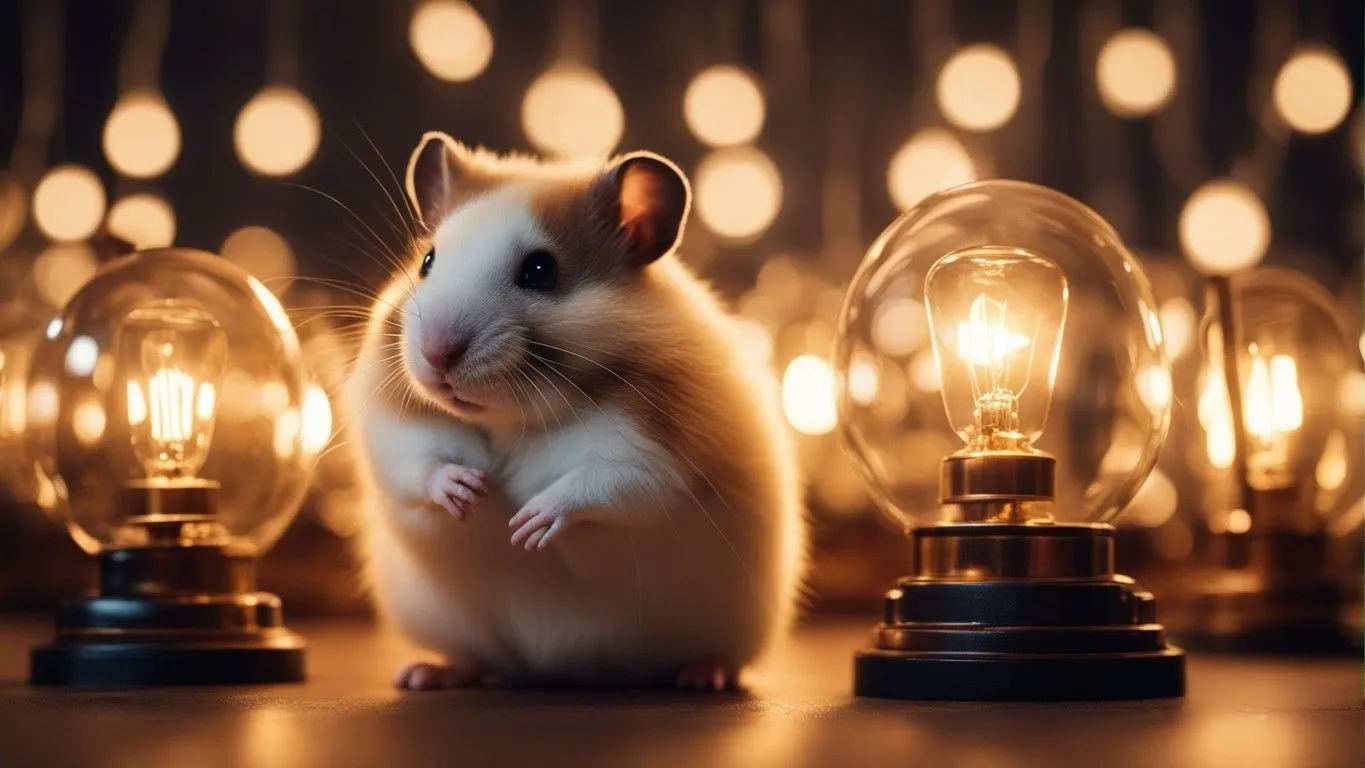Hamsters are nocturnal creatures, but do they actually need light? This is a question that many hamster owners often ponder.
In this section, we will explore the light requirements of hamsters to understand how light impacts their well-being.
- Hamsters are nocturnal and thrive in darkness during their active hours.
- They require natural light during the day but should not be exposed to direct sunlight.
- Direct sunlight can be harmful to their sensitive eyes and disrupt their sleep cycle.
- Avoid artificial lighting as it can disturb their sleep.
- Hamsters can see relatively well in low levels of light but cannot see in complete darkness.
Now that we have a better understanding of hamsters’ light requirements, let’s delve deeper into the natural light cycle for hamsters and its importance in the next section.
The Natural Light Cycle for Hamsters
Understanding the natural light cycle for hamsters is essential for their health and happiness. Hamsters are nocturnal creatures, meaning they are most active during the night.
They have adapted to thrive in darkness and rely on it to feel energetic and ready for their nocturnal activities.
Therefore, it is crucial to provide them with a light cycle that mimics their natural environment.
Hamsters need a regular pattern of light and darkness to maintain their sleep and wake cycle. During the day, they require exposure to natural light, which helps regulate their internal clock and overall well-being.
However, it’s important to note that direct sunlight should be avoided as hamsters are sensitive to light. Direct sunlight can harm their eyes and disrupt their sleep cycle.
Therefore, placing their cage in a room with natural light that is out of direct sunlight is ideal.
Artificial lighting should also be minimized, especially during the night. Exposing hamsters to artificial lights, such as bright room lights or electronic screens, can disturb their sleep and disrupt their natural light cycle.
It’s best to keep their environment dimly lit or use a red or blue light, which has a less disruptive effect on their sleep. Remember, hamsters rely on darkness to feel active and alert during their active period.
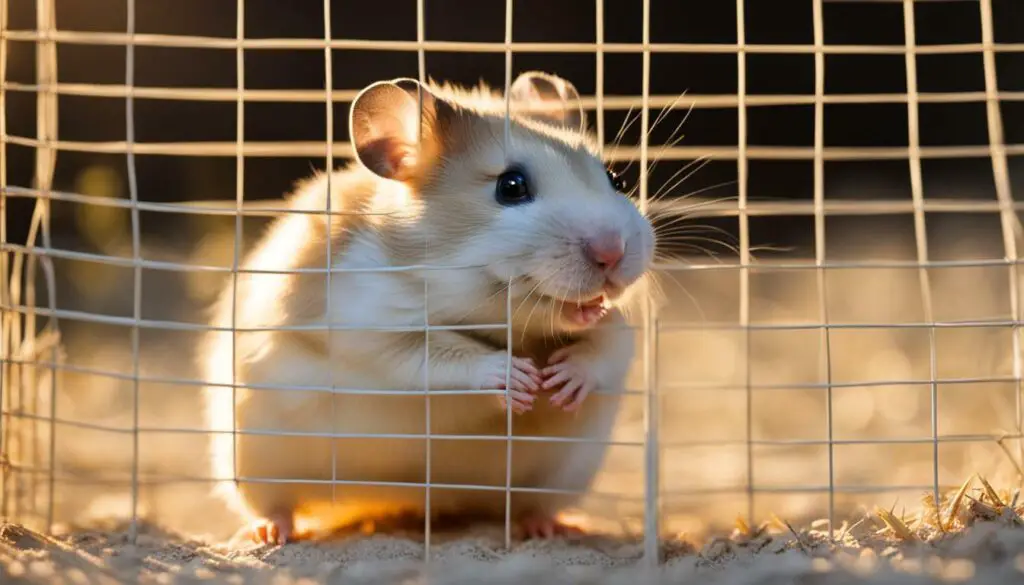
In summary, hamsters thrive on a natural light cycle that aligns with their nocturnal nature. They need darkness during their active period and exposure to natural light during the day, while avoiding direct sunlight.
Artificial lighting should be minimized, especially during the night, to prevent disruption of their sleep cycle.
Understanding and providing optimal lighting conditions for hamsters is crucial for their overall well-being and happiness.
| Advantages of Natural Light for Hamsters | Disadvantages of Direct Sunlight |
|---|---|
|
|
The Role of Natural Light for Hamsters
Natural light plays a crucial role in the lives of hamsters, but how exactly does it benefit them? Hamsters are nocturnal creatures, meaning they are most active during the night.
They have natural sleep and wake cycles that are regulated by light. Exposure to natural light during the day helps maintain their internal clock and promotes overall well-being. It signals to their bodies that it’s daytime, keeping them alert and active.
Hamsters require a balance of light and darkness to thrive. Natural light stimulates their senses and provides them with the necessary environmental cues to carry out their daily activities.
It helps regulate their metabolism, digestion, and mental well-being. By mimicking their natural habitat, you can provide a healthier and more enriching environment for your furry friend.
However, it’s important to note that hamsters should not be exposed to direct sunlight. Hamsters have sensitive eyes and prolonged exposure to direct sunlight can cause damage and discomfort.
It can also disrupt their sleep cycles, leading to sleep disturbances and stress. To protect your hamster’s well-being, place their cage in a room with natural light but away from direct sunlight.
This way, they can still benefit from natural light without any harmful effects.
| Benefits of Natural Light for Hamsters |
|---|
| Regulates sleep cycles |
| Boosts overall well-being |
| Improves mental stimulation |
| Aids digestion and metabolism |
| Enhances their natural behaviors |
The Importance of Light for Hamster Sleep Cycles
Light plays a vital role in regulating hamster sleep cycles. As nocturnal animals, hamsters rely on darkness to feel energetic and ready for their nighttime activities.
They need an uninterrupted period of darkness to ensure proper rest and rejuvenation. Exposure to artificial lights during their designated sleep time can disrupt their sleep patterns and lead to sleep deprivation, which can negatively impact their health and behavior.
While hamsters can see relatively well in low levels of light, they cannot see in complete darkness. Therefore, it’s important to strike a balance between light and darkness in their environment.
Providing natural light during the day and a dark, quiet space during the night will help maintain their natural sleep and wake cycles.
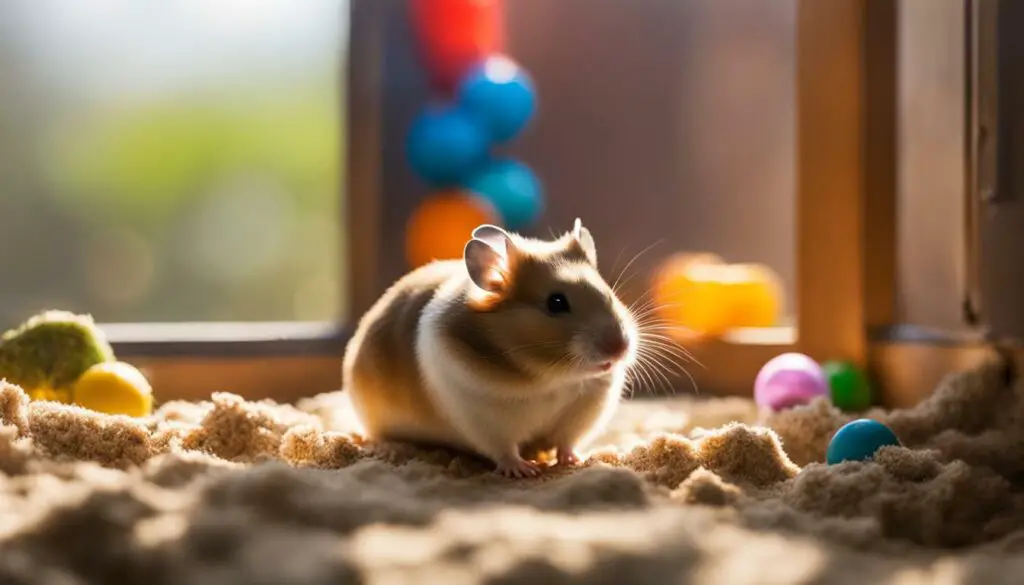
In conclusion, natural light is essential for the well-being of hamsters. It helps regulate their sleep cycles, boosts their overall well-being, and enhances their natural behaviors. By creating an environment with optimal lighting, you can ensure that your hamster remains healthy, active, and happy.
The Hazards of Direct Sunlight for Hamsters
While hamsters need natural light, direct sunlight can have harmful effects on them. Hamsters are sensitive to light, and prolonged exposure to direct sunlight can damage their eyes and disrupt their sleep cycle.
It’s essential to create a safe and comfortable environment for your hamster, and that includes protecting them from the potential hazards of direct sunlight.
Direct sunlight can cause overheating in hamsters, leading to heatstroke or dehydration. Hamsters are small creatures that are highly vulnerable to extreme temperatures, and direct sunlight can quickly raise the temperature inside their cage beyond a comfortable level.
It’s crucial to keep their living space in a cool and shaded area, away from direct sunlight, to prevent any heat-related issues.
Additionally, exposure to direct sunlight can disturb a hamster’s sleep cycle. Hamsters are nocturnal creatures, meaning they are naturally active during the night and sleep during the day.
Direct sunlight can confuse their internal clock and disrupt their sleep patterns, leading to sleep deprivation and potential health problems.
It’s important to provide them with a dark, quiet environment during their resting hours to ensure they get the rest they need.
Hamster Cage Placement Tips:
- Place the hamster’s cage in a room with natural light but away from direct sunlight.
- Avoid placing the cage near windows or areas where direct sunlight can enter.
- Ensure the room temperature remains within a comfortable range for the hamster.
- Consider using curtains or shades to block out any direct sunlight that may reach the cage.
By following these tips and protecting your hamster from direct sunlight, you can create a safe and optimal environment for their well-being.
Remember, while natural light is beneficial for hamsters, it’s crucial to strike a balance and provide them with a suitable light cycle that mimics their natural habitat.
Your hamster will thrive in an environment that meets their light requirements and ensures their overall health and happiness.
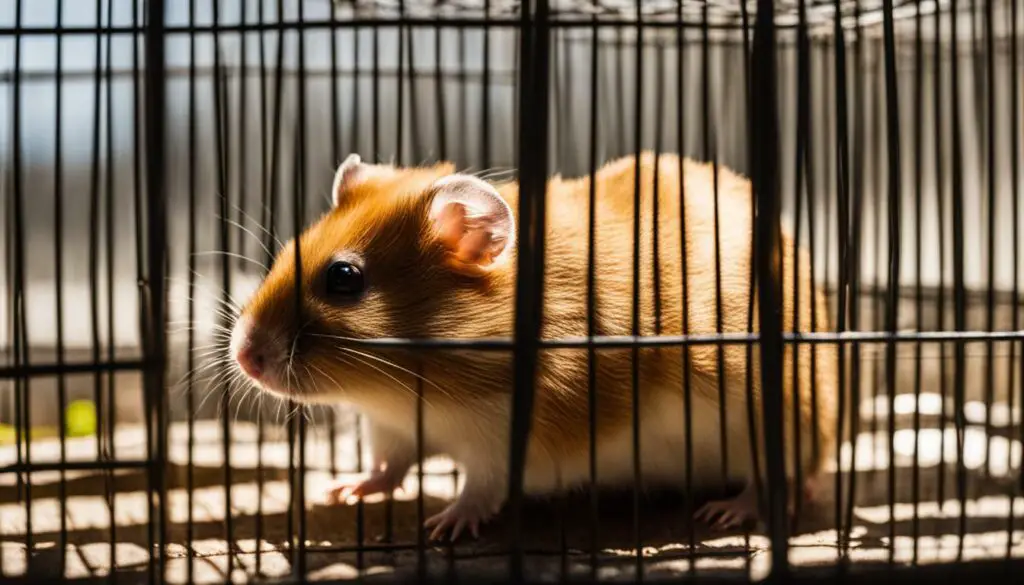
Artificial lighting may seem like a viable option for hamsters, but it can actually disrupt their sleep and well-being. Hamsters are naturally nocturnal creatures, meaning they are most active during the night.
They rely on darkness to feel energetic and ready for their nocturnal activities. Keeping the lights off at night helps maintain their natural sleep and wake cycle.
Direct sunlight should also be avoided as it can be harmful to hamsters. These small animals are sensitive to light, and exposure to direct sunlight can damage their eyes and disrupt their sleep cycle.
It’s important to keep their cages in a room with natural light, but out of direct sunlight.
Hamsters have evolved to adapt to low levels of light, but they cannot see in complete darkness. While they can navigate their surroundings in dim lighting, it is not sufficient for them to see clearly.
However, it’s worth noting that artificial lights in the room, such as night lights or dim lamps, should be minimized as they can disturb their sleep.
In summary, hamsters require natural light during the day to maintain their sleep cycle and overall well-being. However, it’s important to avoid direct sunlight and minimize the use of artificial lighting.
Providing a suitable environment, with proper light conditions, can contribute to their comfort and health.
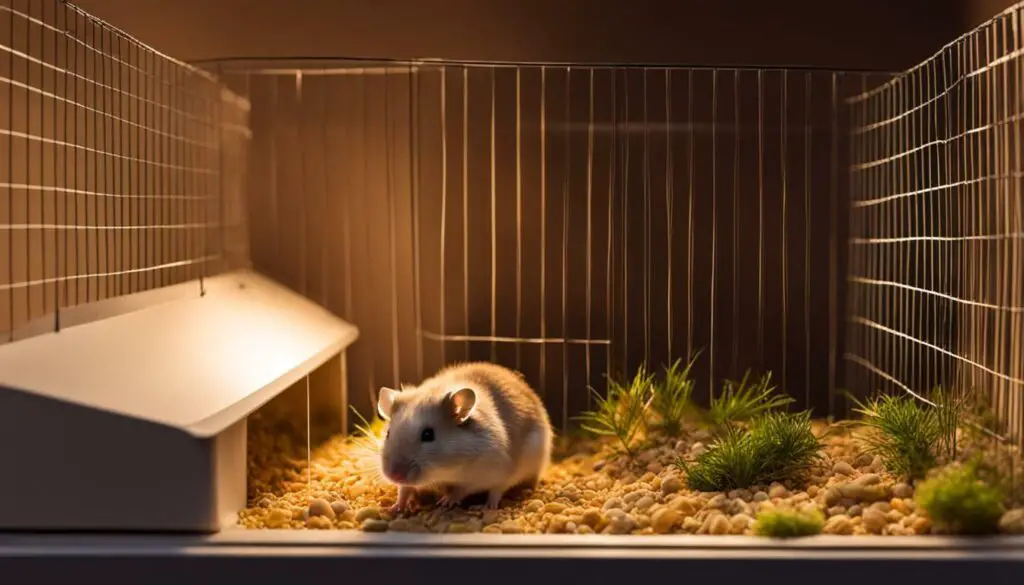
Hamsters have remarkable vision, but can they see in the dark? While hamsters are nocturnal creatures and are adapted to low-light environments, they cannot see in complete darkness.
Their eyes are sensitive to light and they rely on their vision to navigate their surroundings, find food, and interact with their environment.
Although hamsters can see relatively well in low levels of light, complete darkness inhibits their ability to see clearly.
It is a common misconception that hamsters have night vision like some other nocturnal animals. However, their vision is more suited for dimly lit environments rather than complete darkness.
To provide optimal lighting for your hamster, it is important to strike a balance between light and darkness.
Hamsters require a light cycle that mimics their natural habitat, with periods of light during the day and darkness at night.
This helps regulate their sleep-wake cycle and ensures they have the energy they need for their nocturnal activities.
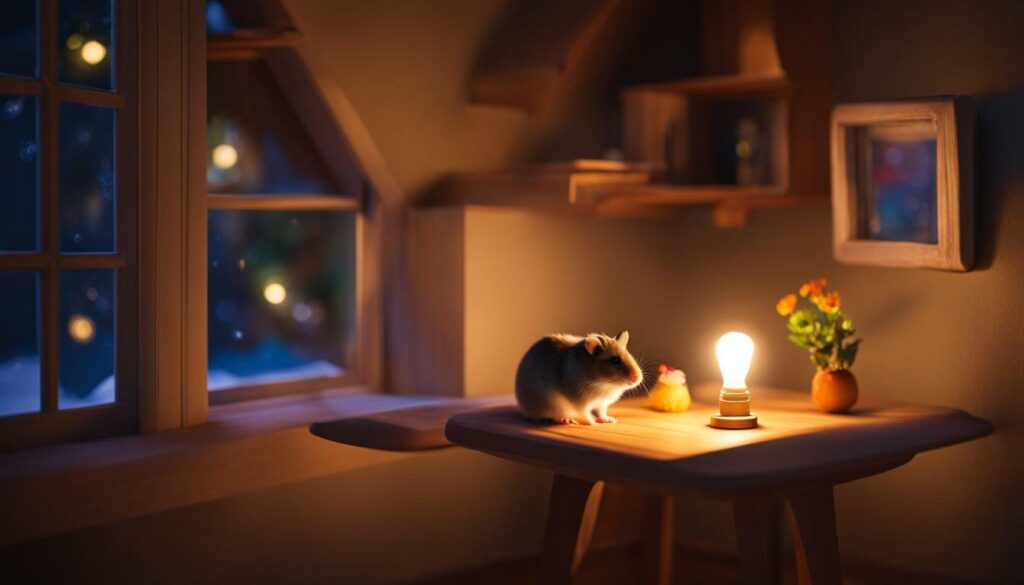
While hamsters do not need direct sunlight, they do benefit from natural light during the day. Placing their cage in a room with natural light, away from direct sunlight, can provide them with the necessary light exposure.
It is not necessary to cover their cage during the day, as long as they have a suitable environment with access to natural light.
Avoiding artificial lighting at night is crucial for hamsters’ well-being and sleep quality. Artificial lights, especially bright ones, can disrupt their sleep cycle and make it harder for them to rest properly.
It is best to keep the lights off in the room where the hamster’s cage is located during their active hours at night.
| Key Points: |
|---|
| Hamsters cannot see in complete darkness |
| They have adapted to low-light environments |
| A light cycle mimicking their natural habitat is important |
| Avoid direct sunlight and artificial lighting at night |
| Natural light during the day is beneficial for hamsters |
Strategies for Providing Optimal Lighting for Hamsters
To ensure your hamster’s well-being, it’s crucial to provide them with the right lighting conditions. While hamsters are nocturnal creatures and prefer darkness during their active hours, they still require some exposure to natural light during the day.
However, it is important to note that direct sunlight should be avoided as it can be harmful to their sensitive eyes and disrupt their sleep cycle.
Instead, place your hamster’s cage in a room with natural light that is out of direct sunlight. This will provide them with a gentle and indirect source of light, which they need to regulate their sleep cycle and maintain their overall well-being.
Natural light also helps in stimulating their natural instincts and behavior.
| Artificial Lighting | Indoor Lighting |
|---|---|
| Artificial lights should be used sparingly when it comes to hamsters. Excessive exposure to artificial lighting can disturb their sleep and undermine their natural sleep-wake cycle. | Indoor lighting can be used to supplement natural light for hamsters. You can opt for soft, ambient lighting in the room where their cage is located. Avoid bright, harsh lights that may cause discomfort to your furry friend. |
It’s important to remember that hamsters can see relatively well in low levels of light but cannot see in complete darkness. Therefore, there is no need to cover their cage during the day. Allow them to experience natural light and darkness in a balanced way to support their natural behavior patterns.
By providing the right lighting conditions for your hamster, you are ensuring their overall well-being and facilitating their natural sleep cycle. Remember to prioritize their comfort and avoid excessive exposure to direct sunlight or artificial lighting. A harmonious blend of natural and indoor lighting will help keep your hamster healthy and happy.
Summary:
- Hamsters need natural light during the day, but not direct sunlight, which can harm their eyes and disrupt their sleep cycle.
- Artificial lighting should be used sparingly, as excessive exposure can disturb their sleep.
- Indoor lighting can supplement natural light and should be soft and ambient to avoid discomfort.
- Hamsters can see well in low light but not in complete darkness.
- No need to cover the hamster’s cage during the day, but ensure it is placed in a room with natural light.

Should you cover your hamster’s cage during the day? Let’s find out. Hamsters are nocturnal creatures and are most active during the night. They eat, exercise, and engage in their nocturnal activities when it’s dark. To maintain their natural sleep and wake cycle, it’s essential to provide them with darkness at night. However, during the day, hamsters do require some exposure to natural light.
Hamsters need natural light during the day, but it’s important to note that direct sunlight can be harmful to them. Hamsters are sensitive to light, and excessive exposure to direct sunlight can damage their eyes and disrupt their sleep cycle. Therefore, it is recommended to place their cage in a room with natural light but out of direct sunlight. This will allow them to benefit from the natural light while keeping them safe from the potential hazards of direct sunlight.
Artificial lights should also be avoided, especially during the night. Unlike humans who can function with artificial lighting, hamsters may find it difficult to sleep and rest properly under artificial lights. The artificial lights can disturb their sleep and overall well-being. Therefore, it is best to keep the lights off in their cage at night to create a dark and comfortable environment for them to sleep peacefully.
Hamsters have the ability to see relatively well in low levels of light but cannot see in complete darkness. So, there is no need to cover their cage during the day to create complete darkness. Instead, ensuring they are placed in a room with natural light will provide them with the necessary light exposure to regulate their sleep cycle and maintain their overall health.
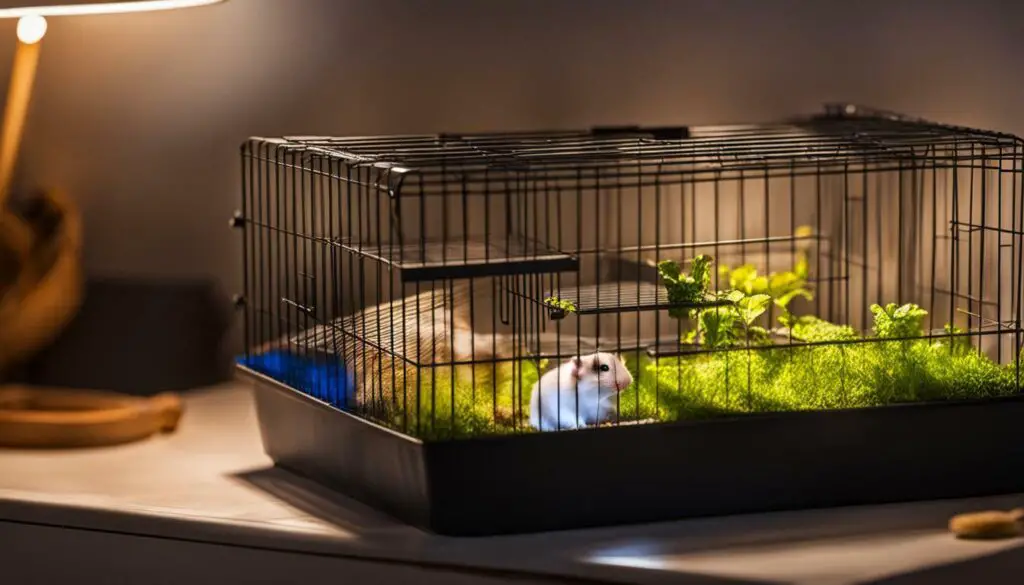
Having a proper understanding of the light requirements for your hamster is crucial in creating a suitable and healthy environment for them. Remember to provide them with natural light during the day, avoiding direct sunlight, and keeping their cage dark and quiet at night. By following these guidelines, you can help your hamster maintain their natural sleep and wake cycle, promoting their well-being and happiness.
The Importance of Light for Hamster Sleep Cycles
Light plays a crucial role in regulating a hamster’s sleep cycle, but why is it so important? Hamsters are naturally nocturnal creatures, meaning they are active during the night and sleep during the day. Their sleep-wake cycle is directly influenced by the presence or absence of light. By providing the right amount of light during the day and darkness during the night, you can establish a healthy sleep routine for your furry friend.
Hamsters require natural light during the day to maintain their internal clock and overall well-being. Exposure to natural light helps regulate their sleep patterns, digestion, and hormone production. It also promotes mental stimulation and physical activity, as hamsters tend to be more active when it’s bright outside. To ensure they receive sufficient natural light, place their cage in a room with windows or provide indirect sunlight.
While natural light is beneficial, it’s important to note that direct sunlight can be harmful to hamsters. These small creatures are sensitive to light, and excessive exposure to direct sunlight can damage their eyes and disrupt their sleep cycle. Avoid placing their cage in direct sunlight and provide shade if necessary. Artificial lights should also be minimized, as they can disturb their sleep and negatively impact their overall well-being.
Hamsters have relatively good vision in low levels of light, but they cannot see in complete darkness. It is not necessary to cover their cage during the day, but it should be placed in a room with natural light, away from direct sunlight. This allows them to experience the natural light cycle while providing them with a safe and comfortable environment. By understanding and meeting their light requirements, you can help your hamster maintain a healthy sleep-wake cycle and contribute to their overall happiness.

| Benefits of Natural Light for Hamsters: |
|---|
| Regulates sleep patterns and internal clock. |
| Promotes mental stimulation and physical activity. |
| Supports digestion and hormone production. |
| Contributes to overall well-being. |
Conclusion
Providing the right amount and type of light is essential for maintaining the health and well-being of your hamster. Hamsters are nocturnal creatures, and they require darkness at night to carry out their natural sleep and wake cycle. It is important to keep the lights off during the night to ensure they feel energetic and ready for their nocturnal activities.
During the day, hamsters benefit from natural light, but it is crucial to avoid direct sunlight. Hamsters are sensitive to light, and direct sunlight can harm their eyes and disrupt their sleep cycle. Instead, place their cage in a room with natural light that is out of direct sunlight to provide the optimal lighting environment.
Artificial lighting should also be minimized as it can disturb hamsters’ sleep. While hamsters can see relatively well in low levels of light, they cannot see in complete darkness. Therefore, it is not necessary to cover their cage during the day. However, ensuring they have access to natural light is important for regulating their sleep cycle and promoting their overall well-being.
In summary, hamsters need the right balance of light to thrive. They require darkness at night, natural light during the day (without direct sunlight), and minimal artificial lighting. By providing an environment with optimal lighting conditions, you can ensure that your hamster stays healthy, happy, and well-rested.
FAQ
Q: Do hamsters need light?
A: Yes, hamsters need light, but their lighting requirements differ from humans. They require natural light during the day but not direct sunlight. Direct sunlight can be harmful to hamsters as they are sensitive to light and it can damage their eyes and disrupt their sleep cycle. Artificial lights should also be avoided as they can disturb their sleep.
Q: Can hamsters see in the dark?
A: No, hamsters cannot see in complete darkness. While they can see relatively well in low levels of light, they still need some amount of light to navigate their surroundings.
Q: Should I cover the hamster’s cage during the day?
A: It is not necessary to cover the hamster’s cage during the day. However, the cage should be placed in a room with natural light that is out of direct sunlight. Hamsters need natural light to regulate their sleep cycle and it is beneficial for their overall well-being.
Q: What are the hazards of direct sunlight for hamsters?
A: Direct sunlight can be harmful to hamsters as they are sensitive to light. It can damage their eyes and disrupt their sleep cycle. Therefore, it is important to keep their cage out of direct sunlight.
Q: What about artificial lighting for hamsters?
A: Artificial lighting should be minimized for hamsters as it can disturb their sleep. It is best to provide them with natural light during the day and keep their cage in a room with adequate natural light.
Q: How can I provide optimal lighting for my hamster?
A: To provide optimal lighting for your hamster, place their cage in a room with natural light but out of direct sunlight. Avoid using artificial lighting in their immediate surroundings, as it can disturb their sleep. It is also important to maintain a consistent light and dark cycle to mimic their natural sleep-wake pattern.
Q: What is the importance of light for hamster sleep cycles?
A: Light plays a crucial role in regulating hamster sleep cycles. Hamsters are nocturnal creatures and need darkness to feel energetic and ready for their nocturnal activities. It is important to provide them with natural light during the day and darkness at night to maintain their natural sleep and wake cycle.

